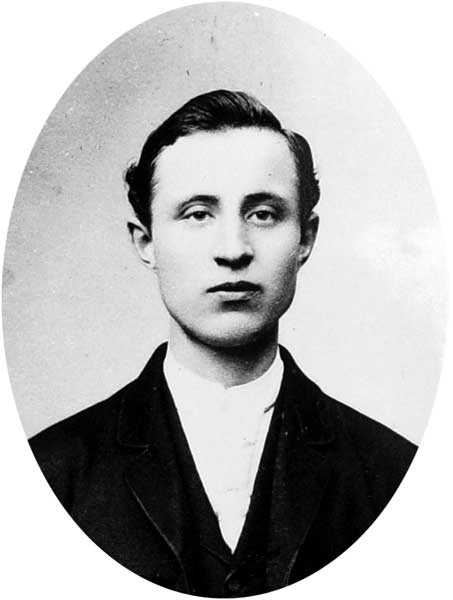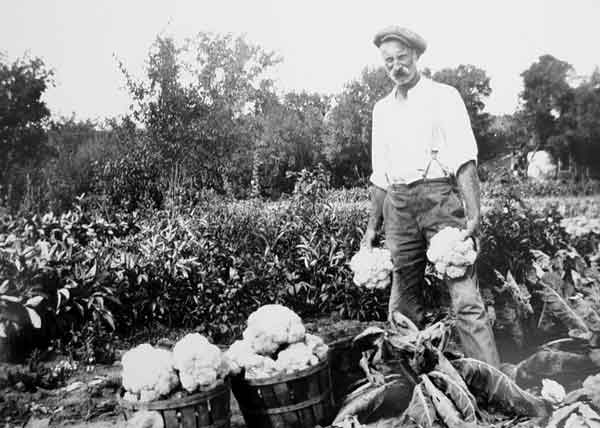 |
Klaas de Jong
|
Market gardener.
It is a little known fact that East Kildonan was once the home of royalty. We’ve heard of the Hendersons, the Munroes and the Gunns. These are the names that are emblazoned across buildings and street signs, so deeply etched into the fabric of the community that it’s easy to forget these names once belonged to living people. However, what’s surprising is the lack of evidence of one of East Kildonan’s finest pioneers Klaas de Jong, Cauliflower King of North America.
Klaas de Jong was born in 1872, in the Netherlands. He came to Canada with the first wave of Dutch immigration, under the Immigration Act of 1893. After working on the railway on the Crow’s Nest Line, de Jong settled in East Kildonan, and shortly after his mother, father, sisters and brothers came to join him.
De Jong took up market gardening on lot 64 (near McLeod Avenue), and proved himself one of the finest gardeners on the continent. S. R. Henderson, a friend and neighbour of Klaas’, urged him to enter his produce in competition in the many garden and vegetable shows that were important affairs in those days. In 1926, in Cleveland, Ohio, he bested all Canadian and American cauliflower contenders, and was crowned Cauliflower King of North America.
As well as being a renowned market gardener, de Jong was a many-faceted man. Archive material contains photos of him alongside his workers in the fields, posed next to prized flowers, with his children and many cherished farm pets; he has had memoirs published, entitled The Cauliflower Crown; his personal correspondence includes poems, many letters to friends, Degas-like drawings of ballerinas that he sketched as a boy in the Netherlands. He is remembered in writings as a kindly, gentle man, whom everyone knew and admired.
The following is an excerpt from a letter written by de Jong in the 1890s, describing a walk through East Kildonan:
“On a very cold morning after eating some porridge withsyrup, I took a walk up to Higgins. It was so calm, no breath of wind. Out of the chimneys smoke going straight up. A heavy fog about six feet from the ground. Very few people out of doors. Those that were out I did not see, but plainly heard them walking in a hurry. From far, I could hear the clop clop of the horse pulling the streetcar, wheels shrieking along the rails. In the distance, I heard a farmer coming with his yoke of oxen, bringing in a load of hay. Jee, how long before I could see them coming through the mist.
“The sun shone brightly, with sun dogs in the sky, with rainbow colored light beams. Above the heavy mist, it looked like millions of tiny diamonds were glittering in the sky. My, it was cold. Had to rub cheeks and nose every so often. Mustache full of ice, even eyelashes freezing together. Only by rubbing keeping them apart. I did not feel the intense cold until I moved. Then I was aware of it and walked to the hay market. There, the poor oxen and horses tied to the sleighs stood with humped up backs, feet close together, tails drawn tight against the legs. Drooping heads. Breath like steam out of the nostrils, long bloody icicles on their nose. Not attempting to eat the hay before them. It was cruel. Later, the law would not allow the farmers to leave the animals for a long time. They had to be stabled. But what was a farmer to do, after selling his load for next to nothing? Ogilvies, that big company, paid only 1.25 to 1.50 for a cord of wood. Private parties paid more, of course. But very little money the farmers got to buy groceries to take home. Real hard times in the ‘90s.”

Klaas de Jong in his garden with his cauliflowers, no date.
Source: Archives of Manitoba
The following are excerpts from a letter written to his daughter, Martha, as he reminisces about his early days in Canada, working on the railways:
“Heavy work and quickness counted. Very soon, the boss took a fancy to me and I found myself doing dangerous fast work. Well, everything went O.K. until the thumb of my left hand got badly smashed between two rails. How it ever became good again is a riddle to me. The bone was sticking out (mark still left). I did wiggle it in place however and the lady in the boarding house made me stick it in a tumbler full of brandy. It hurt like anything and I rather would have that brandy inside of me. Perhaps this way it did the most good ...
“... You see, swearing and cussing was the first thing I learned. As far as the railway men are concerned, the English language only consists of cuss words. After damning me and the whole cursed railroad, the foreman decided to turn back and investigate. Yes, here was the place, sure enough. What an excitement, with a cursing train coming soon. If ever we worked it was right there and then. We soon had the damage repaired, so the train passed safely and as reward for working so hard we were told to sit down and have a smoke. Never a word of thanks and it was never mentioned afterward, but I like to think that I saved the CPR from having a train wreck and that I saved some lives.
“For the rest of the summer, I worked very hard and made a bad friend that way, but my foreman seemed to like me and called me Flying Duchy. It came easier to him than Klaas de Jong. I remember though we had a terrible time with the mosquitoes and at night the army of bed bugs. Dam’n Dam’n and dam’n again. Well, Martha, maybe some other time I can tell you some more out of my early life in Canada. So many things happened in those days which I can never forget. Although they are not important, I cannot help thinking of them.”
De Jong passed away in 1959 at the age of 87. He was predeceased by his wife Betje and daughter Elizabeth. They are all buried in Elmwood Cemetery.
There are family papers at the Archives of Manitoba.
More information:
Cauliflower Crown by Klaas de Jong (1973).
River East Transcona School Division newsletter, The Torch, Spring 2005, submitted by Cheryl Moore (cmoore2@retsd.mb.ca).
Dictionary of Manitoba Biography by John M. “Jack” Bumsted, Winnipeg: University of Manitoba Press, December 1999, 288 pages.
Page revised: 29 February 2008
Memorable Manitobans
This is a collection of noteworthy Manitobans from the past, compiled by the Manitoba Historical Society. We acknowledge that the collection contains both reputable and disreputable people. All are worth remembering as a lesson to future generations.
Search the collection by word or phrase, name, place, occupation or other text:
Custom SearchBrowse surnames beginning with:
A | B | C | D | E | F | G | H | I | J | K | L | M | N | O | P | Q | R | S | T | U | V | W | Y | ZBrowse deaths occurring in:
1975 | 1976 | 1977 | 1978 | 1979 | 1980 | 1981 | 1982 | 1983 | 1984 | 1985 | 1986 | 1987 | 1988 | 1989 | 1990 | 1991 | 1992 | 1993 | 1994 | 1995 | 1996 | 1997 | 1998 | 1999 | 2000 | 2001 | 2002 | 2003 | 2004 | 2005 | 2006 | 2007 | 2008 | 2009 | 2010 | 2011 | 2012 | 2013 | 2014 | 2015 | 2016 | 2017 | 2018 | 2019 | 2020 | 2021 | 2022 | 2023 | 2024 | 2025
Send corrections and additions to this page
to the Memorable Manitobans Administrator at biographies@mhs.mb.caCriteria for Memorable Manitobans | Suggest a Memorable Manitoban | Firsts | Acknowledgements
Help us keep
history alive!